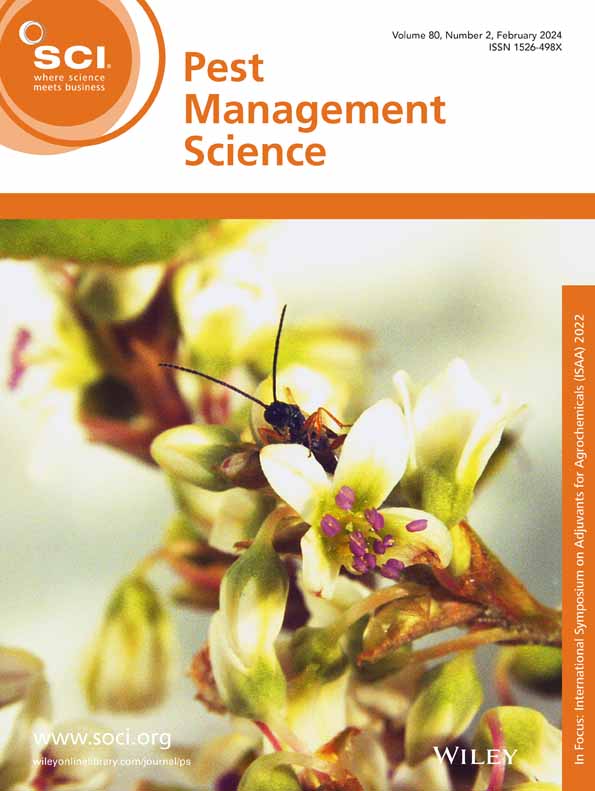Virulence and biocontrol potential of entomopathogenic nematodes against soil‐dwelling stages of the small hive beetle under laboratory and semi‐field conditions
IF 3.8
1区 农林科学
Q1 AGRONOMY
Sitaram Aryal, Alihan Katlav, Clarissa M. House, Robert N. Spooner‐Hart, Michael Duncan, Uffe N Nielsen, James M. Cook, Markus Riegler
求助PDF
{"title":"Virulence and biocontrol potential of entomopathogenic nematodes against soil‐dwelling stages of the small hive beetle under laboratory and semi‐field conditions","authors":"Sitaram Aryal, Alihan Katlav, Clarissa M. House, Robert N. Spooner‐Hart, Michael Duncan, Uffe N Nielsen, James M. Cook, Markus Riegler","doi":"10.1002/ps.8766","DOIUrl":null,"url":null,"abstract":"BACKGROUNDThe small hive beetle (SHB; <jats:italic>Aethina tumida</jats:italic>) is a significant pest affecting honey bees and the global beekeeping industry. The harmful effects of chemical pesticides on bee health, non‐target species and ecosystems highlight the need for sustainable SHB control methods. Soil applications of entomopathogenic nematodes (EPNs) targeting the soil‐dwelling life stages (wandering larvae, pupae and emerging adults) of SHB present a promising biological control approach. We conducted comprehensive laboratory experiments to evaluate the biocontrol potential of 32 Australian isolates of five EPN species (<jats:italic>Heterorhabditis bacteriophora</jats:italic>, <jats:italic>Heterorhabditis indica</jats:italic>, <jats:italic>Heterorhabditis zealandica</jats:italic>, <jats:italic>Steinernema carpocapsae</jats:italic> and <jats:italic>Steinernema feltiae</jats:italic>) against SHB. We also performed a glasshouse experiment testing the efficacy of nine EPN isolates in soil mesocosms that simulated field conditions.RESULTSWe demonstrated that all isolates caused mortality in all life stages, with wandering larvae the most susceptible, followed by pupae and adults. Notably, <jats:italic>H. indica</jats:italic> Hi.HRN caused the highest SHB mortality, while <jats:italic>S. feltiae</jats:italic> Sf.EG was the least effective. These isolates significantly reduced SHB adult emergence, ranging from 9%–93% in autoclaved sterile soil and 16%–59% in natural soil, suggesting interaction with other soil biota. The isolates <jats:italic>H. indica</jats:italic> Hi.HRN, Hi.LMBT and <jats:italic>H. bacteriophora</jats:italic> Hb.HIE2 were the most promising candidates for biocontrol, causing >90% corrected SHB mortality in sterile soil and >80% in natural soil. Additionally, soil application of Hi.HRN caused 33% and 43% mortality of SHB adults after their emergence from natural and sterile soils.CONCLUSIONThe <jats:italic>H. indica</jats:italic> isolates Hi.HRN and Hi.LMBT displayed strong biocontrol potential, warranting further evaluation. © 2025 The Author(s). <jats:italic>Pest Management Science</jats:italic> published by John Wiley & Sons Ltd on behalf of Society of Chemical Industry.","PeriodicalId":218,"journal":{"name":"Pest Management Science","volume":"14 1","pages":""},"PeriodicalIF":3.8000,"publicationDate":"2025-03-11","publicationTypes":"Journal Article","fieldsOfStudy":null,"isOpenAccess":false,"openAccessPdf":"","citationCount":"0","resultStr":null,"platform":"Semanticscholar","paperid":null,"PeriodicalName":"Pest Management Science","FirstCategoryId":"97","ListUrlMain":"https://doi.org/10.1002/ps.8766","RegionNum":1,"RegionCategory":"农林科学","ArticlePicture":[],"TitleCN":null,"AbstractTextCN":null,"PMCID":null,"EPubDate":"","PubModel":"","JCR":"Q1","JCRName":"AGRONOMY","Score":null,"Total":0}
引用次数: 0
引用
批量引用
Abstract
BACKGROUNDThe small hive beetle (SHB;
Aethina tumida ) is a significant pest affecting honey bees and the global beekeeping industry. The harmful effects of chemical pesticides on bee health, non‐target species and ecosystems highlight the need for sustainable SHB control methods. Soil applications of entomopathogenic nematodes (EPNs) targeting the soil‐dwelling life stages (wandering larvae, pupae and emerging adults) of SHB present a promising biological control approach. We conducted comprehensive laboratory experiments to evaluate the biocontrol potential of 32 Australian isolates of five EPN species (
Heterorhabditis bacteriophora ,
Heterorhabditis indica ,
Heterorhabditis zealandica ,
Steinernema carpocapsae and
Steinernema feltiae ) against SHB. We also performed a glasshouse experiment testing the efficacy of nine EPN isolates in soil mesocosms that simulated field conditions.RESULTSWe demonstrated that all isolates caused mortality in all life stages, with wandering larvae the most susceptible, followed by pupae and adults. Notably,
H. indica Hi.HRN caused the highest SHB mortality, while
S. feltiae Sf.EG was the least effective. These isolates significantly reduced SHB adult emergence, ranging from 9%–93% in autoclaved sterile soil and 16%–59% in natural soil, suggesting interaction with other soil biota. The isolates
H. indica Hi.HRN, Hi.LMBT and
H. bacteriophora Hb.HIE2 were the most promising candidates for biocontrol, causing >90% corrected SHB mortality in sterile soil and >80% in natural soil. Additionally, soil application of Hi.HRN caused 33% and 43% mortality of SHB adults after their emergence from natural and sterile soils.CONCLUSIONThe
H. indica isolates Hi.HRN and Hi.LMBT displayed strong biocontrol potential, warranting further evaluation. © 2025 The Author(s).
Pest Management Science published by John Wiley & Sons Ltd on behalf of Society of Chemical Industry.
昆虫病原线虫在实验室和半田间条件下对小蜂房甲虫土栖阶段的毒力和生物防治潜力
背景:小蜂巢甲虫(SHB;蜜蜂病(athina tumida)是影响蜜蜂和全球养蜂业的重要害虫。化学农药对蜜蜂健康、非目标物种和生态系统的有害影响突出表明需要可持续的SHB控制方法。昆虫病原线虫(EPNs)在土壤中的应用是一种很有前途的生物防治方法,其目标是SHB的土壤生活阶段(流浪幼虫、蛹和新兴成虫)。本研究对澳大利亚5种EPN菌株(bacteriophora Heterorhabditis indica Heterorhabditis indica Heterorhabditis zealandica heterorhabdima carpocapsae steinnema feltiae)的32株分离物进行了综合实验室实验,评价其对SHB的生物防治潜力。我们还进行了一个温室试验,测试了9个EPN分离株在模拟田间条件的土壤中生态系统中的功效。结果所有分离株均可在生命的各个阶段引起死亡,其中流浪幼虫最易感染,蛹次之,成虫次之。值得注意的是H. indica你好。HRN引起的SHB死亡率最高,而S. feltiae Sf。EG的效果最差。这些菌株显著降低了SHB成虫出苗率,在高压灭菌土壤中为9%-93%,在自然土壤中为16%-59%,表明它们与其他土壤生物群系相互作用。分离出印度血吸虫。HRN,嗨。LMBT和嗜菌杆菌Hb。HIE2是最有希望用于生物防治的候选菌株,在无菌土壤中校正后的SHB死亡率为90%,在自然土壤中校正后的SHB死亡率为80%。此外,土壤施用Hi。在自然土壤和无菌土壤中出现后,HRN分别造成33%和43%的SHB成虫死亡率。结论印度嗜血杆菌可分离Hi。HRN和你好。LMBT显示出很强的生物防治潜力,值得进一步评价。©2025作者。《病虫害管理科学》由John Wiley &出版;我代表化学工业协会的儿子有限公司。
本文章由计算机程序翻译,如有差异,请以英文原文为准。


 求助内容:
求助内容: 应助结果提醒方式:
应助结果提醒方式:


